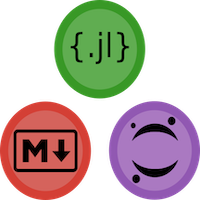Quick Start
This section describes how you can set up your demos easily in five lines of codes.
Manage your demo files
The rules of demo management are super simple:
- you need one demo page to hold all the demo files
- a demo page has several demo sections
- a demo section either
- has other demo sections as nested subsections, or,
- has the demo files
In the following example:
- we have one demo page: "quickstart" –-> The current page you're looking at
- "quickstart" has one demo section: "usage example"
- "usage example" has two demo subsections: "basics" and "julia_demos"
- "basics" section holds all markdown demos
- "julia_demos" section holds all julia demos
- "assets" folders are ignored by
DemoCards.jl - "index.md" is where all demo cards are organized in (aka page template)
- "config.json" are configuration files (there're many)
docs/quickstart
├── index.md
└── usage_example
├── basics
│ ├── assets
│ ├── config.json
│ ├── configure_card.md
│ ├── configure_sec_and_page.md
│ └── simple_markdown_demo.md
├── config.json
└── julia_demos
├── 1.julia_demo.jl
├── 2.cover_on_the_fly.jl
└── assetsDemocards can read the demo structure from your folder structure:
julia> cd("../../../..") do
DemoPage("docs/quickstart")
end
DemoPage("docs/quickstart"):
# Quick Start
## Usage example
### Basics
simple_markdown_demo.md
configure_card.md
configure_sec_and_page.md
### Julia demos
1.julia_demo.jl
2.cover_on_the_fly.jlDeploy your demo page
Deployment is also very simple:
- load a theme using
cardtheme - create a demopage using
makedemos - pass the results to
Documenter.jl - postprocess demos generated by Documenter
# 1. generate a DemoCard theme
templates, theme = cardtheme("grid")
# 2. generate demo files
demopage, postprocess_cb = makedemos("demos", templates) # relative path to docs/
# 3. normal Documenter usage
format = Documenter.HTML(edit_branch = "master",
assets = [theme, ])
makedocs(format = format,
pages = [
"Home" => "index.md",
"Examples" => demopage,
],
sitename = "Awesome demos")
# 4. postprocess after makedocs
postprocess_cb()After it's set up, you can now focus on contributing more demos and leave other works to DemoCards.jl.
Here's the generated democards! You can read it one by one to have a direct experience on how things are managed in DemoCards.jl.
Usage example
Basics
Demos can be written in typical markdown files with Documenter syntax, the only thing DemoCards does is to analyse the folder structure of your markdown files.
Julia demos
It also supports julia source codes (powered by Literate.jl). With this you can not only show typical mardown demo to readers but also provide a downloadable source code and an online notebook link. Another advantage is that you can generate demo assets on the fly(e.g., cover pages, artifacts), which is not an easy task for typical markdown demos using Documenter alone.
What DemoCards.jl does
The pipeline of makedemos is:
- analyze the structure of your demo folder and extracts supplementary configuration information
- copy "
assets" folder without processing - preprocess demo files and save it
- process and save cover images
- generate a postprocessing callback function
Since all files are generated to docs/src, the next step is to leave everything else to Documenter.jl 💯
By default, makedemos generates all the necessary files to docs/src/democards, so it's recommended to put your source files into folders outside docs/src, otherwise it will be processed by Documenter twice. Also, it's often the case that you need to add docs/src/democards to .gitignore.
For advanced usage of DemoCards.jl, you need to understand the core concepts of it.
Currently, there's no guarantee that this function works for untypical documentation folder structure. By the name typical, it is:
.
├── Project.toml
├── docs/
│ ├── demos/ # manage your demos outside docs/src
│ ├── make.jl
│ ├── Project.toml
│ └── src/
├── src/
└── test/

